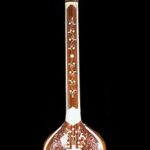Divya Nama Kirtanas – A Bhajana Tradition
“I dwell not in Vaikunta, nor
in the hearts of great Yogis;
Of the Nava Vidha Bhakthis or the Nine Paths of Devotion to Godhead, perhaps
the best understood, widely practiced, and most enjoyed, is KIRTANAM. Singing
one’s way to salvation was practiced long before Sri Thyagaraja Swami’s days.
The Nayanmars and Alwars preached and practiced this Marga or path to
salvation. We have it on the authority of scholars like Dr. S. Ramanathan that
Thevaram and Divya Prabhanda hymns were sung to raga and tala and not merely
recited as poetry. To this day, the Oduvars of the Saivite School and the
Adhyapakas of the Vaishnavite school, sing the Thevarams and Divya Prabhandams,
as part of the temple rituals. Hymns have been composed by various saints and
savants, on their Ishta Devatas, songs in praise of Lord Muruga by
Arunagirinathaar known as Thiruppugazh, in praise of the Lord of the Seven
Hills by Annamacharya, in praise of Purandaravittala by Purandara Dasa, in
praise of Lord Rama by Bhadrachala Ramadasa and in praise of Lord Krishna by
Narayana Thirtha continue to be part of any bhajans; all of them composed
before the time of Sri Thyagaraja Swami.
Bhaja means the worshipping of God or praying to God, singing His praise.
This form of Bhakthi was an important part of the daily worship by the Bhagavathas.
Members of the public joined in at these Bhajans, repeating the verses and
singing in chorus, both at the Uncha Vritti on the streets and at the gathering
in the temple. One Divya Nama Kirtana of the Sadguru in Yamuna Kalyani
describes the Haridasas setting out on their Uncha Vritti Bhajan on the
streets. “Watching the Haridasas getting out on their Bhajan fills our heart
with delight. With their waist-bands tied well, with metallic cymbals in their
hands, with the musical Gotham of the mridangams, with Gnana, Rama Dhyana and
sweet music, surrendering themselves wholeheartedly to the Lord, and watching
them go on the streets fills the heart with delight.
Sri Thyagaraja Swami, being a Bhagavatha in the Bhakthi Marga, strongly
believed that music and devotion combined represented the easiest, sweetest,
and certain path to the attainment of Jeevan Mukthi or liberation from the
cycle of birth and death.
Divyanama Kirtananas
On his reasons for composing the Divyanama Kirtananas, Thyagaraja Swami, in
his Kriti, “Raga Ratna Malika” in Ritigowla, says “As the sole means of my
salvation, with the authority of all Scriptures, as the path to happiness of
all Yogis and for all Bhagavathas to sing together, I composed these songs.
Come, let us sing these together and attain all Sowbhagya.” Collectively a set
of songs composed by Thyagaraja Swami as an expression of bhakthi and bhajans
tradition came to be known as Divya Nama Kirtanas.
There are some 78 kirtans that are in the group of Kirtananas called
Divyanama Kirtananas. These Kirtananas are meant for group singing. They are
generally in the “lambaka” style with one Pallavi and a series of
charanams with the “dathu” or tune to facilitate repetition on choral
singing. In theme and structure, they are varied. The Kirtananas is composed of
a wide variety of popular ragas such as Todi, Sankarabharanam, Karaharapriya
and Saveri, and less well-known ragas such as Andhali, Ahiri, and Balahamsa.
Even in the rarer ragas, these songs have a simple structure, and so anyone with
an ear for music can very quickly learn and join in the singing.
The Ramayana Theme
Mostly the Divya Nama Kirtanana themes are based on the Ramayana, but as
pointed out earlier, there are also songs on human conduct. All important
incidents in Srimad Ramayana are narrated in sequence, from Viswamitra
Yagasamarakshna to pattabishekam, in the kirtana “Vinayamunanu” in Sowrashtram.
The unique beauty of this composition is its poetic excellence. Parayaya Namas
or Synonyms for hands, feet, eyes, etc., is employed to narrate the stories.
The translation of the two Charanams to explain this point is given hereunder,
and it is suggested to interested readers to read the complete song and its
translation from a book by Swami’s kirtanas.
“When will I see the feet that marched with Viswamitra, when will I see the
feet that brought Vimochana to Ahalya, when do I see the foot that pressed down
the Siva Dhanus at the Swayamvara of Sita, when do I see the feet that Janaka
washed with milk at his daughter’s wedding, when will I see the hands which
tied the Mangala sutra to Sita, when will I see the hands which took the
strength of Parasurama, when will I see the hands which killed Virada and when
will I see the hands which gave Abhaya to the rishis in the forest?” In this
manner, the story of Ramayana is taken from Bala Kanda to Aranya Kanda using
synonyms. The singing of this song will be the singing of the whole of
Ramayana, and so this song is referred to as Samkahepa Ramayana or condensed
Ramayana.
In The kirtana “Pahirama” in Kharaharapriya, each stanza is devoted to one
of the members of Rama’s parivara or entourage and we are told how Rama gave
happiness to Sita with his words, to Lakshmana with his eyes, to Bharata with
his embrace, to Sathrugna with his nod of approval and to Anjaneya with praise.
This song is full of raga bhava and brings out, within the limitations of a
kirtana without sangatis, the nuances of this rakthi raga.
As an example of this, the Yadukula Kambhoji composition “Sri Rama, Jaya
Rama” in khanda chapu may be cited. Starting with Kausalya and wandering what
great penance she had performed to earn the privilege of being able to kiss the
lovely cheeks of Sri Rama, Dasaratha, Sowmitri, Kowsika, Ahalya, Janaka, Sita
and Narada are all mentioned in the same manner, mentioning the joy they got
out of Rama. Incidentally, the arrangement of the episodes and characters is
such that this composition also narrates Ramayana from Yaga Rakshanam to Sita
Kalyanam.
True Bhaktha
The song “Karuna Jaladhe” in Nadnamakriya lists the qualities of a true
bhaktha after mentioning that the experience of a true bhaktha is totally
different from the findings of one who does not know Rama. The song lists the
various sections of a true bhaktha, which ensure his constant thought of Rama
and his presence with the devotee. In the last charana, Swami refers to the
advaitic experience, which comes to a devotee practicing for long and Bhakthi
marga. “Neevanni teyani Balkudure, Neeve Thannani Kulgukudure.” They (the true
devotees) will find and speak of you being everything and they being you.” What
a worthwhile reward for a waiting bhaktha?
Human Foible
Listing the commonly occurring misconducts and weaknesses of man, in the
kirtana “Rama Rama Krishnayanare” in Gowlipanthu, Swami says that even the
worst sinners are known to have changed for the better and attained salvation
by singing the name of the Lord. “Kaani Panulu Kori Kori, karanguchundu
Nannavulu” and “Challani Vakulu Balki Swanthaamanalamaina Varu” meaning that
those who hanker for things that are not right and to which are not entitled
and those who speak with honey on their tongue but with fire in their hearts,
even they will reform and benefit by singing Rama, Rama, Krishna.
Manasika Puja
One can go on and on giving examples of the beauty, wisdom, and music of
these priceless gems have to offer. Let us be contented with one final example
of Swami’s stress on purity of thought, unselfishness and un-attachment to
fruits of worship, by quoting the kirtana “Paripalaya Paripalaya” in
Reetigowlai “O: God, my pure body, is your temple; my sthira or nischala
chithha (unwavering) is the peeta or asana for you; my pure thoughts are
Ganga water for your abhisheka; my devotion is the golden cloth for you to
wear. The burning away of the fruits of my past evil deeds is the sambrani
dhoopam. My happiness which cannot be separated is the thamboolam for you and
so on.
Summary
The list of such songs and their themes is long, and I suggest that those
who are interested may go through the texts and authentic translation for
further study. It is for this very purpose of giving the interested student and
scholar a more comprehensive coverage; to enable even those not taking part in
the singing, to appreciate the superb concepts enshrined in the divyanama
Kirtananas that, for the first time ever, Sri T. S. Parthasarathy has included
in his book of Thyagaraja kritis, a word for word translation.
It may be mentioned here that the late Dr. R. Krishnaswami of Glaxo Labs was
also, in no mean measure, responsible for the successful publication of this
book. In 1967, the 200th Jayanthi Aradhana of Sri Thyagaraja Swami was
celebrated all over the country. At this time, Dr. Krishnaswami, a great and
ardent devotee of the Saint, was very keen on the publication of an authentic
version of the Swami’s composition by Sri Sadguru Sangeetha Samajam,
Purasawalkam, Chennai. It was greatly due to his tireless endeavors that this
publication was brought out on the Aradhana day in 1967 (First edition). A
second edition was brought out in 1972. This information has been added to Dr.
R. K’s contribution after his passing away in June 1991.
My request: do not put away to another day the joy of reading, listening to,
or singing those musical gems. It is impossible to convey the happiness which
can come from the singing of these songs. An essay on sugar cannot convey the
sweetness of sugar. You have to taste it yourself. In his composition “Anandam
Anandamaye” in Bhairavi, the Swami says, “Even Brahma, Indira, and Siva cannot
express in words all the happiness they experience; Who am I, a poor mortal
with a very limited vocabulary?”
By P. Sreenivasan
Do not reprint or publish without permission vidyarthifoundation@gmail.com



